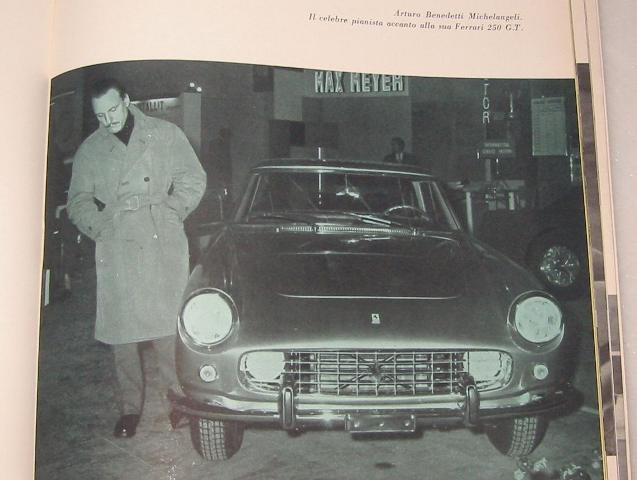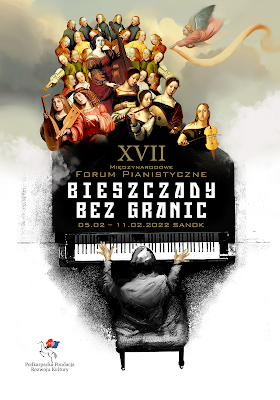Arturo Benedetti Michelangeli (1920-1995) and his Ferraris - not only an immortal Chopinist
 |
| Arturo Benedetti Michelangeli (1920-1995) |
These character traits made him curiously and uniquely gifted in his penetration of those uniquely emotional, inaccessible aspects of Chopin, seldom engaged or touched by lesser mortals. His refined, poetic recordings of the G minor Ballade, the F minor Fantasia or the B flat minor Scherzo are formidably expressive, replete with the untranslatable Polish emotion of żal in his inspired phrasing, nuance, rubato and glorious tone. The mazurkas are a kaleidoscope of shifting colour, intimacy, timbre, simplicity and rhythmic independence of the hands.The sensuality of the B flat minor Sonata, the affecting delineation of the Polish melancholy of death in the Marche funèbre, the deeply moving cantabile of grieving reflection, the miraculous legato and the unsettling writhing of the disinherited mind in the contrapuntal web of the Presto.
But his elegant musical genius is not what I wish to discuss in this reflection. What could I possibly add to what has already been hyperbolically written by numerous critics far more gifted than I ?
Many of you will know my fascination with classic cars, an obsession that runs alongside my musical life-blood. Many great musicians and artists have been equally fascinated, as human beings often are, by speed, inspired design and distinguished, fast motor cars. Michelangeli was one, the great German conductor Herbert von Karajan was another. He used to drive home in exceptional Porsches so fast that farmers brought in their animals lest they stray onto the road.
Herbert von
Karajan, the legendary Austrian conductor, was not only known for his mastery
in music but also for his passion for luxury cars. Over the years, he owned an
impressive collection of high-performance vehicles, reflecting his taste for
precision and elegance. Here’s an overview of Karajan’s relationship with cars:
1. His Love of Driving
Karajan was an avid driver who valued the artistry of engineering and speed. He
often compared conducting orchestras to driving powerful cars, emphasizing
control, precision, and a sense of freedom. Driving became one of his key
hobbies and a way to relax away from his demanding musical career.
2. The Ferrari Connection
Karajan had a particular fondness for Ferrari, owning several iconic models:
• Ferrari 275 GTB: This classic sports car, renowned for its beauty and
performance, was a highlight of his collection.
• Ferrari 365 GT4 BB (Berlinetta Boxer): Known for its mid-engine design, it
reflected his love for cutting-edge automotive technology.
Karajan was famously photographed with some of these Ferraris, further
cementing his image as a man of refined taste.
3. The Porsche 959
One of the most notable cars in his collection was the Porsche 959, a
revolutionary supercar of its time. Karajan was one of the first customers to
receive this model, showcasing his affinity for rare and innovative vehicles.
He admired its advanced engineering, including its all-wheel drive and
cutting-edge aerodynamics.
4. Rolls-Royce and Mercedes-Benz
Karajan’s collection wasn’t limited to sports cars. He also owned luxurious
models like Rolls-Royce and high-end Mercedes-Benz vehicles, reflecting his
preference for comfort and sophistication in certain settings.
5. The Symbolism of Cars in His Life
For Karajan, cars were more than just machines—they were symbols of his
personality:
• Precision: He appreciated cars for their meticulous engineering, akin to his
approach to music.
• Speed: Karajan often spoke about his love for speed, seeing parallels between
the energy of a fast car and the dynamics of music.
• Elegance: His choices, from Ferraris to Rolls-Royces, echoed his preference
for elegance in both his professional and personal life.
6. A Man of Dual Worlds
Karajan’s love for cars and music bridged two worlds: one of artistic
creativity and the other of mechanical brilliance. He was known to drive his
cars on the winding roads of the Alps, finding inspiration in the landscapes
and the thrill of the drive.
The artist Andy Warhol was fascinated by Rolls-Royce.
 |
| Andy Warhol's Phantom III Shooting Brake (3CP134) |
 |
| Andy Warhol's Silver Shadow II |
Michelangeli was born in Brescia. He assures us his family was of 'Slavic' Croatian ancestry. This was the Italian town where the immortal road race known as the Mille Miglia originated in 1927 and was last run in 1957. In many ways it had been inspired by the far older classic Targa Florio. He studied to be a doctor but abandoned this career for music. He was a pilot in the Italian Air Force during WW II and loved flying. His association with Brescia and fast cars would have made a Mille Miglia fascination and addiction almost inevitable. It is rumoured he may have taken some part in the April 1953 race in a Fiat Parisotto 750 Sport. Many legends abound around such escapades ....
These discoveries gave me extraordinary excitement, enhancing the image of an immortal pianist who had also been a pilot and shared my passion for rare, fast cars. I seem to have inherited this trait from my great-uncle, the Australian concert pianist Edward Cahill (1885-1975). He owned an Alvis Speed 20 and later in life, during WW II, drove a Type 57 Bugatti around Lac Léman (Lake Geneva) after charity concerts for interned troops and international exiles. In his biography I had written:
Eddie
had one curious interest seemingly at odds with being a classical musician. He was interested in
motor racing, had even done a little in Australia and arranged to visit the Brooklands
circuit over Easter. He felt a connection between the two forms of risk- taking
– one with Liszt at the limits of the keyboard concertizing and the other at the 'ten-tenths' limits of a fast car on a race track. The adrenalin rush that resulted from the
proximity of an accident, of danger, stimulated his rather neurotic temperament. A moth
attracted to the flame. (The Pocket Paderewski - Michael Moran , Melbourne 2016) pp.73-74
In her remarkably detailed book on the artist Michelangeli written by his pupil the Polish pianist Lidia Kozubek, (Arturo Benedetti Michelangeli as I knew him - Peter Lang GmbH, Frankfurt am Main, 2011) we learn much of his personal characteristics apart from his sublime pianism and musicality. Although one of the highest-paid pianists, he lived rather a frugal life of great generosity and often gave to charitable causes. You really should read it for a fuller more balanced picture of this extraordinary man.
Kozubek quotes the Italian author and journalist Grazia Livi who writes in Epoca :
'...the one luxury he does allow himself - perhaps on account of an overwhelming desire to get the better of reality - is a particularly fast and powerful car. (Michelangeli enjoyed living dangerously).' p.13
Kozubek regarded him as a Renaissance man, such was his versatility and extensive knowledge of diverse spheres of art, science and life.
As a good host, Michelangeli made a point of adding variety to the daily round, appreciating as he did the regenerative powers of relaxation for a tired mind and body. He would take us on outings to beautiful Italian towns - to visit an ancient monument, a museum, or antique dealer's (he was an expert on antique furniture) or simply to a good supper in some especially fine location, of which of course there is no shortage in Italy. Always an added attraction of such trips was riding in Michelangeli's car, often at a giddy speed of over 100 miles miles per hour! - and regardless of whether it was day or night. When travelling alone on the Italian motorways, he would do up to 150 miles per hour. He was a very able, sure driver, and fast driving appeared to unwind him.
Michelangeli was also a pilot:his friend the Italian conductor Ettore Gracis mentions that he had some 300 flying hours behind him. Sometimes he even borrowed a plane and flew to a concert being held in some remote town far away. (p.14)
Below are some of the cars Michelangeli owned and drove. He had had a passion for Ferrari and was a 'Saturday friend' of Enzo Ferrari himself (the day reserved for special friends) and is mentioned in his biography. Michelangeli is also mentioned in the obituary of the great coachbuilder Sergio Scaglietti (1920-2011) who created some of the most beautiful Ferraris.
The Italian coachbuilder Sergio Scaglietti, who has died aged 91, was responsible for the bodywork of some of the most beautiful sports and racing cars ever built – a series of Ferraris created between the mid-1950s and the late 1960s: the 750 Monza, the Testarossa, the 250GT and GTO, the Lusso, the Dino 246 and the California Spider. These cars were bought by the type of customer who helped establish Ferrari's glamorous reputation: the film director Roberto Rossellini, the playboy Porfirio Rubirosa, the conductor Herbert von Karajan, the actor Marcello Mastroianni, the Shah of Iran, the pianist Arturo Benedetti Michelangeli, ex-King Leopold of Belgium and Prince Bernhard of the Netherlands.
(Guardian Obituary 24th November 2011 of Sergio Scaglietti, Italian coachbuilder, born 9 January 1920; died 20 November 2011)
 |
| Enzo Ferrari (1898-1988) at the entrance to the Ferrari factory |
 |
| Arturo Benedetti Michelangeli with his Ferrari 250 GT short-wheelbase Coupé - one of the greatest, most exciting of all Ferrari road cars for the gentleman weekend racer |
| (possibly manufactured 1958 with coachwork by Pininfarina) |
 |
| Arturo Benedetti Michelangeli with his Ferrari 330 GT 2+ 2 Coupé (1964-1965) No doubt he bought a 2+2 to accommodate his fearless pupils! |
Replacing the 250 GTE, the 330 2+2 was Ferrari’s second attempt at a 4-seat Grand Tourer. Michelangeli clearly took more than one pupil as a passenger according to Kozubek. The car was often criticized for its distinctive dual headlights which was a feature of the body designer Tom Tjaarda. Not long afterward Ferrari reverted back to the single headlight treatment for the road-going model.
 |
| Arturo Benedetti Michelangeli at the wheel of an MG MGA (1955-1962) Arturo Benedetti Michelangeli leaving his Jaguar XJ6 or perhaps XJ12 (1968-1973) |







Comments
Post a Comment